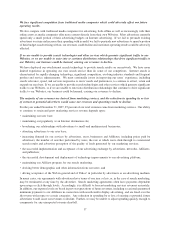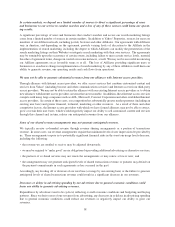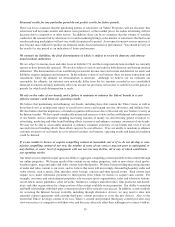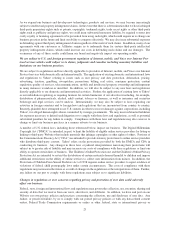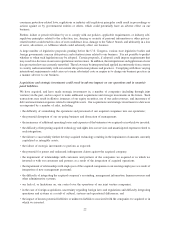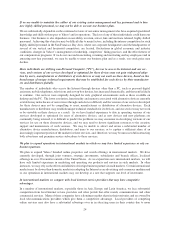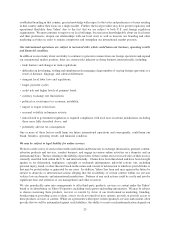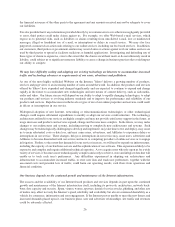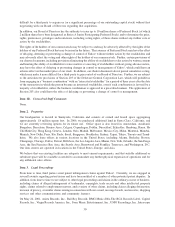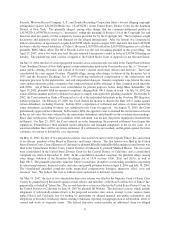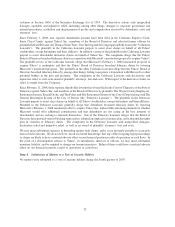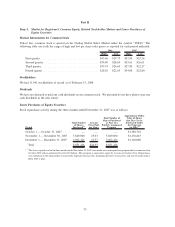Yahoo 2007 Annual Report Download - page 28
Download and view the complete annual report
Please find page 28 of the 2007 Yahoo annual report below. You can navigate through the pages in the report by either clicking on the pages listed below, or by using the keyword search tool below to find specific information within the annual report.the financial resources of the other party to the agreement and any amounts received may not be adequate to cover
our liabilities.
It is also possible that if any information provided directly by us contains errors or is otherwise negligently provided
to users, third parties could make claims against us. For example, we offer Web-based e-mail services, which
expose us to potential risks, such as liabilities or claims resulting from unsolicited e-mail, lost or misdirected
messages, illegal or fraudulent use of e-mail, or interruptions or delays in e-mail service. We may also face
purported consumer class action suits relating to our online services, including our fee-based services. In addition,
our customers, third parties or government entities may assert claims or actions against us if our online services are
used by third parties to spread or facilitate malicious or harmful applications. Investigating and defending any of
these types of claims is expensive, even to the extent that the claims are without merit or do not ultimately result in
liability, could subject us to significant monetary liability or cause a change in business practices that could impact
our ability to compete.
We may have difficulty scaling and adapting our existing technology architecture to accommodate increased
traffic and technology advances or requirements of our users, advertisers and publishers.
As one of the most highly trafficked Websites on the Internet, Yahoo! delivers a growing number of products,
services and page views to an increasing number of users around the world. In addition, the products and services
offered by Yahoo! have expanded and changed significantly and are expected to continue to expand and change
rapidly in the future to accommodate new technologies and new means of content delivery, such as rich media,
audio and video. Our future success will depend on our ability to adapt to rapidly changing technologies, to adapt
our products and services to evolving industry standards and to improve the performance and reliability of our
products and services. Rapid increases in the levels or types of use of our online properties and services could result
in delays or interruptions in our service.
Widespread adoption of new Internet, networking or telecommunications technologies or other technological
changes could require substantial expenditures to modify or adapt our services or infrastructure. The technology
architectures utilized for our services are highly complex and may not provide satisfactory support in the future, as
usage increases and products and services expand, change and become more complex. In the future, we may make
changes to our architectures and systems, including moving to completely new architectures and systems. Such
changes may be technologically challenging to develop and implement, may take time to test and deploy, may cause
us to incur substantial costs or data loss, and may cause users, advertisers, and Affiliates to experience delays or
interruptions in our service. These changes, delays or interruptions in our service may cause users, advertisers and
Affiliates to become dissatisfied with our service and move to competing providers of online services or to engage
in litigation. Further, to the extent that demands for our services increase, we will need to expand our infrastructure,
including the capacity of our hardware servers and the sophistication of our software. This expansion is likely to be
expensive and complex and require additional technical expertise. As we acquire users who rely upon us for a wide
variety of services, it becomes more technologically complex and costly to retrieve, store and integrate data that will
enable us to track each user’s preferences. Any difficulties experienced in adapting our architectures and
infrastructure to accommodate increased traffic, to store user data and track user preferences, together with the
associated costs and potential loss of traffic, could harm our operating results, cash flows from operations and
financial condition.
Our business depends on the continued growth and maintenance of the Internet infrastructure.
The success and the availability of our Internet-based products and services depends in part upon the continued
growth and maintenance of the Internet infrastructure itself, including its protocols, architecture, network back-
bone, data capacity and security. Spam, viruses, worms, spyware, denial of service attacks, phishing, and other acts
of malice may affect not only the Internet’s speed, reliability and availability but also its continued desirability as a
vehicle for commerce, information and user engagement. If the Internet proves unable to meet the new threats and
increased demands placed upon it, our business plans, user and advertiser relationships, site traffic and revenues
could be adversely affected.
26



